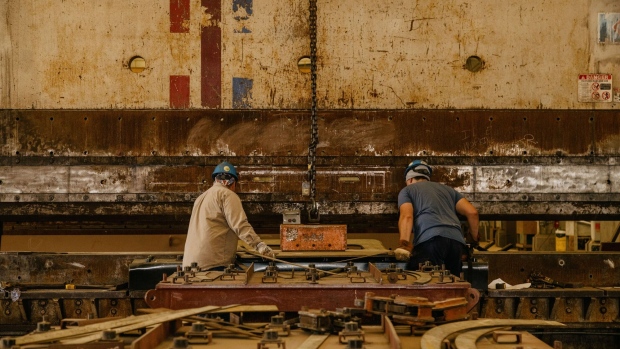Apr 4, 2023
A Football Field-Sized Boat Will Service US Offshore Wind Farms
, Bloomberg News

(Bloomberg) -- At a Louisiana shipyard Tuesday, construction slowed so executives, politicians and reporters could tour a boat that’s almost as long as a football field. Some workers welded steel bulkheads, while others used an industrial press the size of a trailer to bend metal. At the center of the activity sat the Eco Edison, a concrete and expensive sign that some companies are pressing ahead in the fledgling offshore wind industry.
When completed next year, the boat is expected to be the first US-built vessel to service offshore wind farms.
Over the past six months, inflation and political pushback have become significant challengers for offshore wind, a sector that the Biden administration sees as a crucial source of power in the push to purge fossil fuels from the electric grid. Rising costs delayed two huge farms off the coast of Massachusetts by at least a year. Republican lawmakers seized on a rash of whale deaths to demand the whole industry stop in its tracks. And when Rhode Island asked developers to propose a new wind farm, it received just a single bid. Even Danish energy giant Orsted AS, one of the companies building the big boat in Louisiana, said it would take a hit of about $365 million on a farm it’s building off New York.
None of that has deterred Orsted or Massachusetts utility Eversource Energy from continuing construction of the 262-foot Eco Edison. “This shipyard and this vessel are living proof that the US offshore wind industry is creating jobs today,” David Hardy, chief executive officer for Orsted in the Americas, said at the shipyard on Tuesday.
While offshore wind has a more established track record in Europe — though it faces challenges there, too — the industry is basically starting from scratch in the US after a decade of stumbles. The first large farms are scheduled to start producing power later this year, and President Joe Biden has set a goal of 30 gigawatts of offshore wind by 2030. (One gigawatt is roughly equal to the electricity-generating capacity of a large nuclear reactor or natural gas-fired power plant.)
Read More: Wind Farms Fall Victim to Global Inflation Fight
That goal was given a boost last year by the passage of the Inflation Reduction Act. The landmark climate legislation includes valuable tax credits for clean energy, but developers are eager for Internal Revenue Service guidance on how exactly those tax credits will be implemented. “It’s great that the law was passed, but until we understand the nuances we can’t really count on that,” Hardy said. In the meantime, the country’s offshore ambitions could lead to significant economic activity. Orsted and Eversource declined to share how much the Eco Edison will ultimately cost, but the boat employs some 400 local workers and boasts a supply chain crossing 34 states.
“There’s going to be a lot more to come,” said House Majority Leader Steve Scalise, a Republican who represents the district where the boat is being built.The Eco Edison will operate out of Long Island, New York, to service the wind farms Orsted and Eversource are building in the Atlantic Ocean: the South Fork Wind, Revolution Wind and Sunrise Wind farms. Together those projects are expected to generate enough electricity to power more than 1 million homes.
That power will be especially valuable during cold Northeast winters, said Eversource Vice President Mike Ausere, when natural gas prices can jump as the fuel is needed for both electricity generation and heating. “You asked about momentum? We're going full-tilt,” Ausere said.
(Updates with comment from Eversource in 10th paragraph.)
©2023 Bloomberg L.P.







